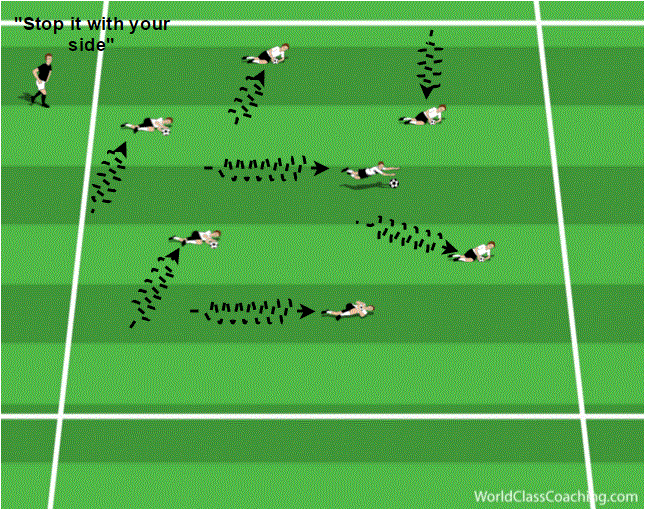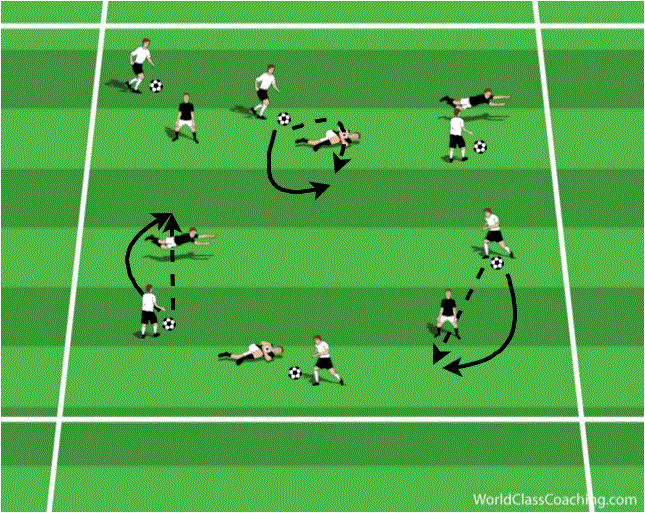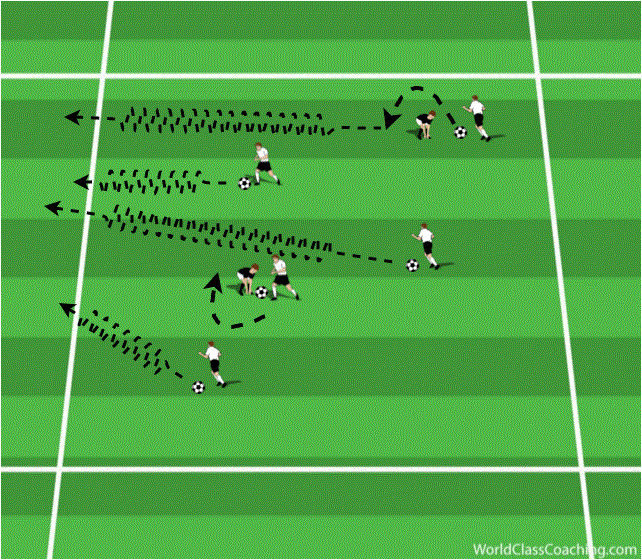By Chris Kouns
USSF A License (USSF Coaching Education Instructor) – NSCAA Premier Diploma (NSCAA Coaching Education Associate Staff Coach) – Head Women’s Soccer Coach – Georgia Gwinnett College
In these activities we are helping children in the formative stages of their soccer development become more comfortable with the ball and adjusting the pressure on the ball so they can still be competitive.
Body Part Game
Set-Up
Create a grid about 15X15 yards. All the players should be inside the grid with a ball of their own.
Instructions
The coach shouts a part of the body that the player uses to stop the ball. For example right foot, left foot, knee, etc.

Variations
Coach can point to a body part and players must see it then stop the ball with it. This will force them to get their head up!
Coaching Points
- Encourage players to constantly move and zig-zag while dribbling.
- Keep Close possession.
- Head up to avoid collisions.
The Dribbling Warm-Up
Setup
Create a grid that is approximately 20X20 yards. Organize the team into groups of two. Each group of two players needs one ball.
Instructions
One player will work while the other player rests. Roll through each of these 3 exercises.
- While inside the grid, the player without the ball should stand with their legs spread apart. On the coach’s command, the other player with the ball should dribble and play their ball through the legs of any of the players with their legs spread and run around the standing player and receive the ball on the other side. Each time the player successfully plays the ball between a set of legs that player gets a point. Have each player compare their score to their partners score.
- Next, have the player without the ball lay on their side. Now the player must dribble up to the player laying on their side, stop the ball, and flick the ball OVER the player laying on their side and jump over that players legs. To avoid injury, instruct the players to ONLY approach the player from the backside. Again have the player’s count each time they successfully flick the ball over the human wall and compare their scores to their partner’s score.
- Finally, instruct the players without the ball to stretch their calf muscle by crossing their legs and leaning forward touching their hands to the ground. Their position should almost be a pushup position with their hands and feet on the ground like a bridge. Now, have the players with the ball pass the ball underneath the player making the bridge (between their feet and hands), and jump over the feet part of the bridge. Again, have the players count the number of times they successfully knock the ball under the bridge and jump over their feet. Have them compare their scores to their partner

Coaching Points
- Keep the players moving
- Head up and aware of what’s going on around them
- Keeping the ball close
- Using all parts of the foot to perform the exercises.
- Have fun!
Frogger
Set-Up
Build a grid 20X30 (may adjust if too large or small). Every player must be in the grid with a ball except for 2 players who will be the FROGS.
Instructions
All of the players will start on one side of the grid and try to make it to the other side while maintaining control of the ball on the dribble. The two FROGS must hop and try to tag the other players as they try to get to the other side. When a player is tagged, they both become a frog. Play continues until only 2 players are left, who become the frogs for the next game.

Variations
- Mandate certain parts of the foot that may only be used to dribble.
Coaching Points - Start getting the players dribbling to get their heads up to avoid the frogs.
By Chris Kouns: USSF A License (USSF Coaching Education Instructor) – NSCAA Premier Diploma (NSCAA Coaching Education Associate Staff Coach) – Head Coach Georgia Gwinnet College Women’s Soccer (GA)


